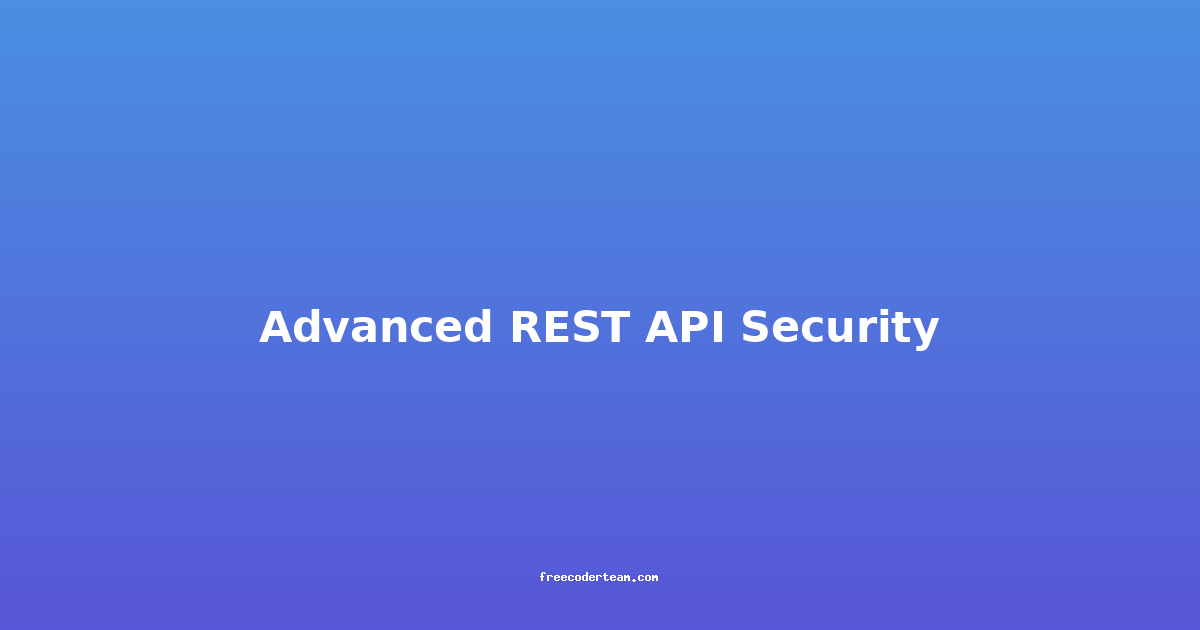Advanced REST API Security: Best Practices and Practical Insights
REST APIs are the backbone of modern web and mobile applications, enabling seamless communication between client and server. However, as APIs become more complex and widely used, securing them against potential threats becomes paramount. This blog post delves into advanced REST API security, covering best practices, actionable insights, and practical examples to help developers and security professionals build robust and secure APIs.
Table of Contents
- Understanding REST API Security Threats
- Best Practices for Securing REST APIs
- Practical Examples
- Actionable Insights
- Conclusion
Understanding REST API Security Threats
Before diving into best practices, it's essential to understand the common security threats that REST APIs face:
- Man-in-the-Middle (MITM) Attacks: Intercepting communications between the client and server.
- SQL Injection: Injecting malicious SQL queries to manipulate the database.
- Cross-Site Request Forgery (CSRF): Forcing authenticated users to perform unwanted actions.
- Cross-Site Scripting (XSS): Injecting malicious scripts into web pages.
- API Key Exposure: Hardcoding or transmitting API keys insecurely.
- Rate Limiting Vulnerabilities: Allowing attackers to overwhelm the server with requests.
- Broken Authentication: Weak or improperly implemented authentication mechanisms.
Understanding these threats helps in building more robust security measures.
Best Practices for Securing REST APIs
1. Use HTTPS
HTTPS (Hypertext Transfer Protocol Secure) is the foundation of API security. It encrypts data transmitted between the client and server, protecting it from eavesdropping and tampering.
-
Why HTTPS?
- Prevents data interception.
- Ensures data integrity.
- Authenticates the server.
-
Implementation Example:
# Use a reverse proxy like Nginx to terminate SSL/TLS server { listen 443 ssl; server_name api.example.com; ssl_certificate /path/to/certificate.crt; ssl_certificate_key /path/to/private.key; location /api { proxy_pass http://localhost:8080; } } -
Actionable Tip: Always enforce HTTPS and redirect HTTP requests to HTTPS using a 301 redirect.
2. Implement Authentication and Authorization
Authentication verifies the identity of a user, while authorization determines what actions the authenticated user is allowed to perform.
-
OAuth 2.0: A widely adopted standard for API authentication.
-
JWT Tokens: Lightweight and stateless tokens for secure authentication.
-
Implementation Example (OAuth 2.0):
# Redirect user to OAuth provider for authentication https://provider.com/oauth/authorize?response_type=code&client_id=CLIENT_ID&redirect_uri=https://api.example.com/callback
3. Validate Inputs
Unvalidated inputs can lead to injection attacks like SQL Injection or XSS. Validate and sanitize all incoming data.
-
JSON Schema Validation: A powerful tool for validating JSON payloads.
-
Implementation Example (JSON Schema):
const Ajv = require('ajv'); const ajv = new Ajv(); const schema = { type: 'object', properties: { name: { type: 'string', maxLength: 50 }, age: { type: 'number', minimum: 18, maximum: 120 } }, required: ['name', 'age'] }; const validate = ajv.compile(schema); const valid = validate({ name: "John", age: 25 }); if (!valid) { console.error(ajv.errorsText(validate.errors)); }
4. Rate Limiting
Rate limiting prevents abuse by restricting the number of requests a client can make within a given time frame.
- Purpose: Protects against DoS (Denial of Service) and brute-force attacks.
- Implementation Example (Using Express.js):
const rateLimit = require('express-rate-limit'); const apiLimiter = rateLimit({ windowMs: 15 * 60 * 1000, // 15 minutes max: 100, // Limit each IP to 100 requests per windowMs message: "Too many requests, please try again later." }); app.use('/api', apiLimiter);
5. Use JWT Tokens
JWT (JSON Web Tokens) are widely used for secure authentication. They are stateless and can be easily verified on the server side.
- Example (Generating a JWT Token):
const jwt = require('jsonwebtoken'); const token = jwt.sign({ userId: 123, role: 'admin' }, 'secretKey', { expiresIn: '1h' }); console.log(token);
6. Secure Session Management
If your API uses sessions, ensure they are secure by:
-
Using HTTP-only cookies to prevent client-side JavaScript from accessing them.
-
Enforcing the
SecureandSameSiteflags on cookies. -
Implementation Example (Express.js):
app.use(session({ secret: 'your-secret-key', resave: false, saveUninitialized: true, cookie: { secure: true, // Only send over HTTPS sameSite: 'strict', // Prevent CSRF httpOnly: true // Prevent client-side access } }));
7. Implement CORS Policies
CORS (Cross-Origin Resource Sharing) controls which origins can access your API. Misconfigured CORS can lead to security vulnerabilities.
- Implementation Example (Express.js):
const cors = require('cors'); app.use(cors({ origin: 'https://trusted-domain.com', methods: ['GET', 'POST'], allowedHeaders: ['Authorization', 'Content-Type'] }));
8. Monitor and Log API Activity
Monitoring and logging are crucial for detecting and responding to security incidents.
-
Use Tools: Tools like ELK Stack (Elasticsearch, Logstash, Kibana) or Splunk can help monitor API activity.
-
Log Sensitive Information: Log IP addresses, timestamps, and request parameters (without sensitive data like passwords).
-
Implementation Example (Winston Logging):
const winston = require('winston'); const logger = winston.createLogger({ level: 'info', format: winston.format.json(), transports: [ new winston.transports.Console(), new winston.transports.File({ filename: 'api.log' }) ] }); app.use((req, res, next) => { logger.info({ method: req.method, path: req.originalUrl, ip: req.ip, userAgent: req.get('User-Agent') }); next(); });
Practical Examples
Example 1: Implementing OAuth 2.0
OAuth 2.0 is a popular protocol for API authentication. Here's a basic example using the OAuth 2.0 Authorization Code Flow:
-
Redirect to OAuth Provider:
https://provider.com/oauth/authorize?response_type=code&client_id=CLIENT_ID&redirect_uri=https://api.example.com/callback -
Handle Redirect Callback:
const axios = require('axios'); app.get('/callback', async (req, res) => { const code = req.query.code; try { const response = await axios.post('https://provider.com/oauth/token', { grant_type: 'authorization_code', code: code, redirect_uri: 'https://api.example.com/callback', client_id: 'CLIENT_ID', client_secret: 'CLIENT_SECRET' }); const accessToken = response.data.access_token; res.send(`Access Token: ${accessToken}`); } catch (error) { res.status(500).send('Error fetching access token'); } });
Example 2: Input Validation with JSON Schema
Using JSON Schema to validate API requests ensures that only expected data is processed.
const Ajv = require('ajv');
const ajv = new Ajv();
// Define the schema
const userSchema = {
type: 'object',
properties: {
username: { type: 'string', minLength: 3, maxLength: 50 },
password: { type: 'string', minLength: 8 }
},
required: ['username', 'password']
};
// Compile the schema
const validate = ajv.compile(userSchema);
// Validate the incoming request
app.post('/register', (req, res) => {
const isValid = validate(req.body);
if (!isValid) {
return res.status(400).json({ error: ajv.errorsText(validate.errors) });
}
// Proceed with registration logic
res.status(201).json({ message: 'User registered successfully' });
});
Actionable Insights
- Stay Updated: Security threats evolve, so stay informed about new vulnerabilities and update your APIs accordingly.
- Use Frameworks Wisely: Leverage security modules provided by frameworks like Express.js, Django, or Spring.
- Regular Audits: Conduct regular security audits and penetration testing.
- Train Your Team: Educate developers about secure coding practices and common vulnerabilities.
- Fail Securely: Ensure that failed authentication or authorization attempts do not leak sensitive information.
Conclusion
Securing REST APIs is a multifaceted task that requires a combination of robust practices and continuous monitoring. By implementing HTTPS, validating inputs, using JWT tokens, and enforcing rate limiting, developers can significantly enhance the security of their APIs. Additionally, leveraging tools like OAuth 2.0 and JSON Schema provides a structured approach to authentication and data validation.
Remember, security is an ongoing process. Regularly update your APIs, stay informed about new threats, and always prioritize user data protection. By following the best practices outlined in this blog, you can build APIs that are not only functional but also secure.
By combining theoretical knowledge with practical examples, this guide aims to empower developers to create APIs that are resilient against modern security threats. Happy coding, and stay secure! 🚀🔒
Disclaimer: Always consult security experts and conduct thorough testing before implementing security measures in production environments.




